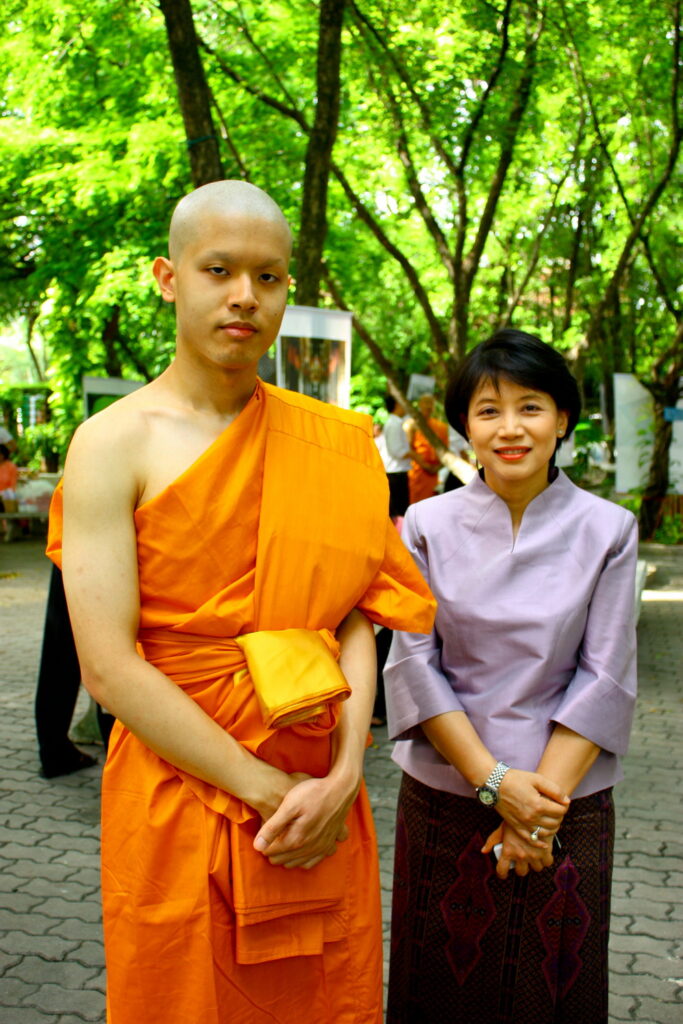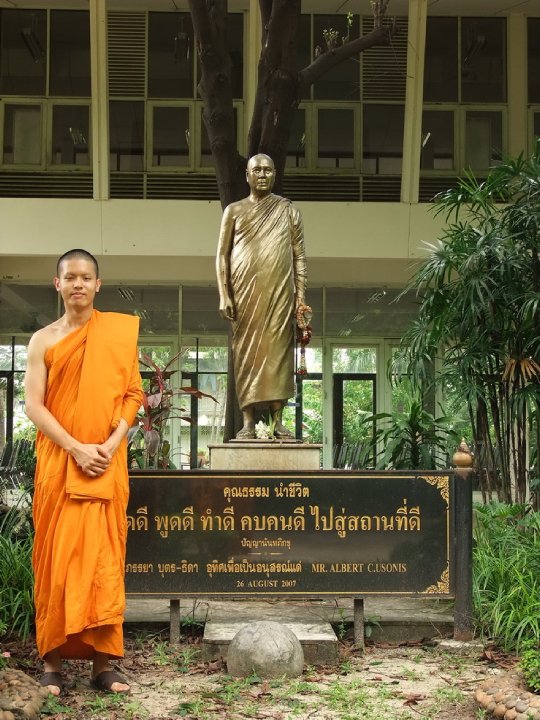Recently, I was added to a group of fellow former monks in the batch of 2010. We were ordained together as a group at Chonlapratarn Rangsarid temple on the outskirt of Bangkok before the Buddhist Lent in 2010. Time flies. It has been a full decade since I experienced the tranquility and engaged in intensive practices of Buddhism for 15 days. Before I left the temple after the period of slightly more than 2 weeks, I promised myself to continue building on the lessons I learned at the temple to become better at practicing Buddhism, free(er) from all the rituals.
A path to ordination
For Thais at least, you can be ordained as a novice or a monk depending on your age and your willingness. Those under the age of 20 can only be ordained as novices whereas those 20 or above are eligible to be ordained as monks or novices. The main difference is that a novice adopts 10 precepts or rules (dasa-sila) while a monk adopts a more disciplined life with 227 precepts. Many Thai men choose to be ordained at least once and there can be several reasons for this. Several want to take some time off their busy lives to learn more about the Buddha’s teachings and practice meditation under close guidance and supervision of senior monks. The ideal period for many is at least 3 months of the Buddhist lent. Should time be not on your side, 30, 15, and 7 days are convenient alternatives.
My father passed away when I was 19. I had a choice of becoming a novice on the day of my father’s cremation as per the prevailing custom or I could wait until I became 20 to be ordained as a monk. I chose the latter. For me, monk ordination would be a period of intensive learning of the key teachings of the Buddha with the focus on practice – how to cut yourself from all the so-called ‘earthly desires’, what are the effective ways to meditate, for example.
My high regard for ordination as an intensive Buddhism course stemmed from the time I attended the compulsory ‘Buddhism Retreat’ with my school when I was 16. The temple was founded by Panyanantha Bhikku, a senior monk who devoted his life to resist widespread superstitions that claim to be Buddhism-related. He was also close to Buddhadasa Bhikku, a well known monk who focused on practices and denied extravagances and unnecessary rituals. At the Retreat, we were barred from the outside world, staying in a forest-like temple on the outskirt of Bangkok eating two meals a day and learning to meditate. I liked the style and this became the foundation of my choice for the temple which I was to be ordained at.
I was ordained at Chonlapratarn Rangsarid temple, where Panyanantha Bhikku was the abbot. He passed away just a few years before. The new abbot used to be his close assistant. I registered to be ordained as the youngest in the 2010 Buddhist Lent batch as I only turned 20 a few months before the date of ordination.
Building Blocks
Chonlapratarn Rangsarid temple where I stayed as a monk had a predetermined set of activities for the newbie monks. I would say it was an intensive Buddhism course. This was how a day in a life of a monk looked like at the temple.
Newbie monks would wake up before 4 am, wash and head to the chanting hall. Following a half-hour chanting, we would meditate for another 15-20 minutes. We would then leave the temple to take up alms from people who live nearby. Since I was one of the youngest, my route was one of the furthest from the temple. Afterwards, we would sit around in semi circle in the temple to take up alms from those who had come to make merits at the temple. Following that, we would have breakfast at around 7-7.30. We would be given some time to tidy up our room, clean up the plates and do some washing. At around 9am, we would attend classes of Buddhism and meditation. Around eleven, we would be having lunch and this would be the last meal of the day. In the afternoon, we would go back to do more meditation. At around 3-4pm, we would be back in our rooms reading or exchanging views on certain topics related to Buddhism. Newspapers were not allowed and talks of ‘earthly topics’ were discouraged. Around 5-6pm, we would attend the assembly where our supervisor would talk to us about all sorts of things. Problems, issues or ways to improve our practices. At seven, we would have evening chanting, some more meditation before retiring to sleep at 8 pm.
A decade on
The temple’s attitude towards ordination is not for newly ordained monks to sit still during the day. Rather, the temple encourages monks to make the most of their time studying and practicing meditation which I am forever grateful for. The two-week period was clearly becoming one of the defining chapter in my life. Before leaving monkhood, I was determined to apply what I learned and continue some of the practices, especially meditation to the best of my ability.
And here I am, a decade on. I want to take this opportunity to reflect on the ideas, lessons and practices from my short but meaningful monkhood.
Free(er) from Rituals
In Thailand at least, what I take to be core values and teachings of Buddhism have been decorated with several rituals. Practiced over the years, people have stopped questioning the relations between such practices and the core values and teachings. I mentioned earlier that there is a prevailing custom for a male relative of the deceased to be ordained as a novice on the day of the cremation. I later learned that, during the time of the Buddha, there was no such thing as ordination during the funeral of the deceased with a belief to help sending off the deceased to somewhere blissful. Ordination had only one purpose which was to rid oneself of earthly desires to pursue nirvana (never to be born again).
I learned also that some rituals were nice and satisfying to have but they were not necessary. Some were even contrary to the teachings of Buddhism which encourages individuals to be attentive to their current state of mind and to be weary of extreme happiness or sadness.
Therefore, after finishing my monkhood, I was determined to try focusing my life on the core values and teachings of Buddhism and cut down on excess rituals as much as I could. I am glad that I can still hold on to that commitment, at least to a certain extent.
Meditation as a part of life
Meditation was a major part of our routine when living as monks in Chonlapratarn Rangsarid temple. Many of us may have this idea in mind. Meditation is something you do sitting down, not moving and thinking about only one thing for a certain period of time. At the temple, we were introduced to walking meditation, lying down meditation, and even meditation while engaging in activities. Also, meditation is not only about blocking all thoughts and focusing only on our breathing but it is also about being attentive to whatever thoughts and feelings that may arise at any given moment – knowing yourself at the current state of mind.
I found the meditation lessons very useful and I still practice a form of meditation every now and then. It has helped me looking after my emotions and reminding me to focus on the present.
To sum up, the period of 15 days spent being a monk was a defining period of my life. It was a different life, simple, tranquil yet full of meaning. Over the past ten years, I am glad to have had the strength to focus on the substance of Buddhism’s core values, teachings and practices rather than various forms of rituals that have been added over many generations. As an earthly layman, an excuse obviously, I have not been doing as much meditation as I had hoped. Yet, the methods I learned at the temple have continued to be an excellent guide whenever I choose to meditate. I have tried to integrate meditation into my daily routine. Building on some success, I shall continue to do so.

July 2010

![]()